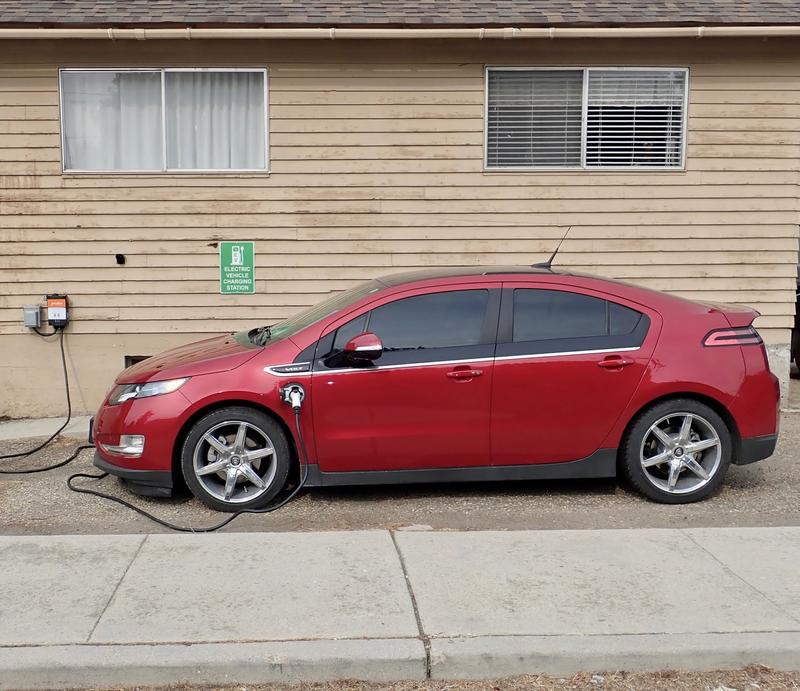Two months ago, I posted about our Chevy Volt - a plug in hybrid that runs us around the Treasure Valley for an awful lot less money than paying for gas. This week, I’m attempting to write a bit of a local guide to electric vehicles - specifically in the Treasure Valley (the Boise area in Idaho). We’ve got cheap (and fairly clean) power out here, middle of the road gas prices, and I happen to think EVs or PHEVs make an awful lot of sense for most people!

If you’re not in the Treasure Valley and are interested in EVs, you’ll probably learn something too - but this is tailored for the local market in terms of price numbers. Keep reading!
You Should Consider an EV/PHEV!
My goal in this post is simple enough - I want to convince you that you should almost certainly buy an EV or PHEV for your next vehicle purchase. They can be a great replacement to an existing car, and they’re also a great addition to a collection of vehicles. I absolutely understand that a BEV isn’t a great option for an “only vehicle” out here (in most cases - if cost is no concern it can be done), but even if you have other vehicles for certain uses, EVs make a great addition that saves an awful lot of money.

Our family has four main vehicles - a Chevy Volt, a Ford F350 (CCLB 4x4, as Jesus would have driven - He was a carpenter!), and some Urals (sidecar motorcycles - see above). We switch between them as needed. The Volt is the primary vehicle as it’s cheapest to run. I’ll take a Ural if I’m going into town separately (sometimes with my daughter), and the truck is used as a truck (mostly, as little as possible). Right now, there’s a couple yards of compost in a flatbed trailer behind it. I pick the cheapest available one for the particular requirements, which does involve regularly telling my daughter that, no, we’re not going to take the truck for a small D&B run that will fit in the car.
ICEs, Hybrids, PHEVs, REEVs, and EVs, Oh My!
If you’ve not spent much time around vehicles that aren’t pure internal combustion, there’s quite the soup of acronyms related to how energy is stored and how power gets to the wheels. There are several general categories of vehicles that use electrons from a battery (as opposed to just combustion electron exchange), and you can think of it as a continuum, not discrete categories. Some vehicles blur the lines, but most things you’ll find fit in one of these categories.
ICE: Internal Combustion Engine
Just about everything in the Treasure Valley these days is an ICE - Internal Combustion Engine. Gas (or diesel, or natural gas, or propane, or something else “generally burny”) goes in a suitable tank, is injected with air into a cylinder, ignited, burns, expands, shoves a piston down (or, occasionally, a triangular rotor around), and you get power and exhaust gasses. Time tested, simple, pretty bad on the thermal efficiency front, but it’s the default option. They work well, they’re easily available, you can drive them just about anywhere, shops know them, and it’s almost certainly what you have in 2019. Fuel economy ranges all over the place, but 25-40 miles per gallon of gas is a pretty typical range for a car. Trucks… well, when you need to haul a couple tons of material, a Civic just isn’t going cut it.

Hybrids
A hybrid is a car that uses a combination of gas and electric power to move around but only takes gasoline energy input. Electric motors are very efficient at low speeds where gas engines aren’t, and if you can use an electric motor to assist a gas engine in some inefficient regions of operation, you can improve the efficiency of a car by a good amount. Most importantly, you can recapture kinetic energy for later use. Instead of turning, say, 3500 lbs at 45mph into about 90Wh of heat, you recapture it for later use. The Prius has been out for two decades, and Honda’s Insight was an early entry in this category as well.
A hybrid will typically have a small battery pack (on the order of 1-2kWh) that’s designed to do two main things: Store energy from regenerative braking and help with acceleration. Typically, you’ll get some slow speed creeping (like in a parking lot) on the electric motor alone, but it depends on the system details. Regenerative braking is responsible for a lot of the efficiency gains for in-town driving. This also means the brakes don’t get much use, and the pads last pretty much forever if you drive gently. On the flip side, if you never use the friction brakes, they may seize up and stop working properly - so make sure you give the brakes a good workout every now and then!
In 2019, quite a few vehicles have a hybrid drivetrain in them, and many small cars have it as an option. You’ll typically see 40-60mpg depending on what kind of driving you do - and you’ll see a far smaller gap between city and highway economy than you would with a pure ICE. The hybrid system helps recover the energy otherwise lost in city driving. But, importantly, a hybrid won’t charge from the wall. If it does, it’s a Plug-in Hybrid Electric Vehicle!
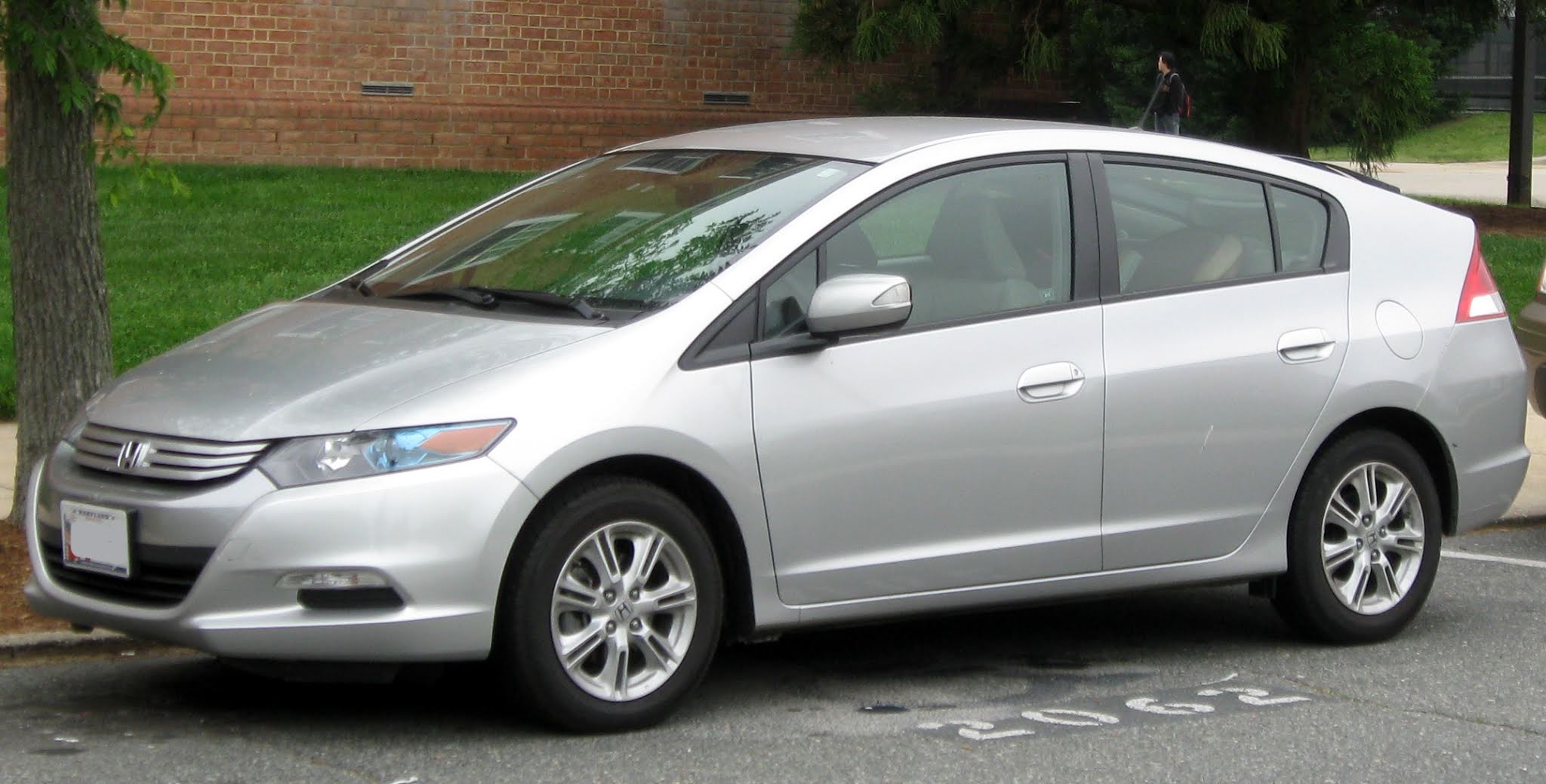 |
| It's not a Prius. It's still almost as ugly as a Prius. |
PHEV: Plug-in Hybrid Electric Vehicle
The nest step towards a pure electric vehicle is a PHEV - plug-in hybrid electric vehicle. It’s like a hybrid - but it plugs in!
A PHEV typically has a far larger battery pack than a hybrid. The battery pack is able to move the car for a substantial distance without having to use the gas engine instead of just assisting with braking energy recovery. You get all the advantages of a hybrid (regenerative braking, assist on acceleration), but you can charge the car from the power grid and drive a substantial distance on battery alone before the gas motor kicks in (at which point you can drive until the tank is empty, then refill the tank and keep driving).
The Chevy Volt is the best known option here (and is a properly good car). The first generation gets about 30-40 miles on battery while the second generation gets 45-55 miles on battery. After that, the gas motor kicks in and you keep driving as long as there’s fuel in the tank. The plug in Prius fits in this category as well, with a 10-30 mile range (depending on generation) before the gas motor kicks in.
Fuel economy on gas varies, but is typically worse than a hybrid. However, starting your day with 30+ miles of electric range, every day, means that the typical fuel economy is far, far better. Our Volt’s lifetime fuel economy in our hands is around 180 miles per gallon of gas used.
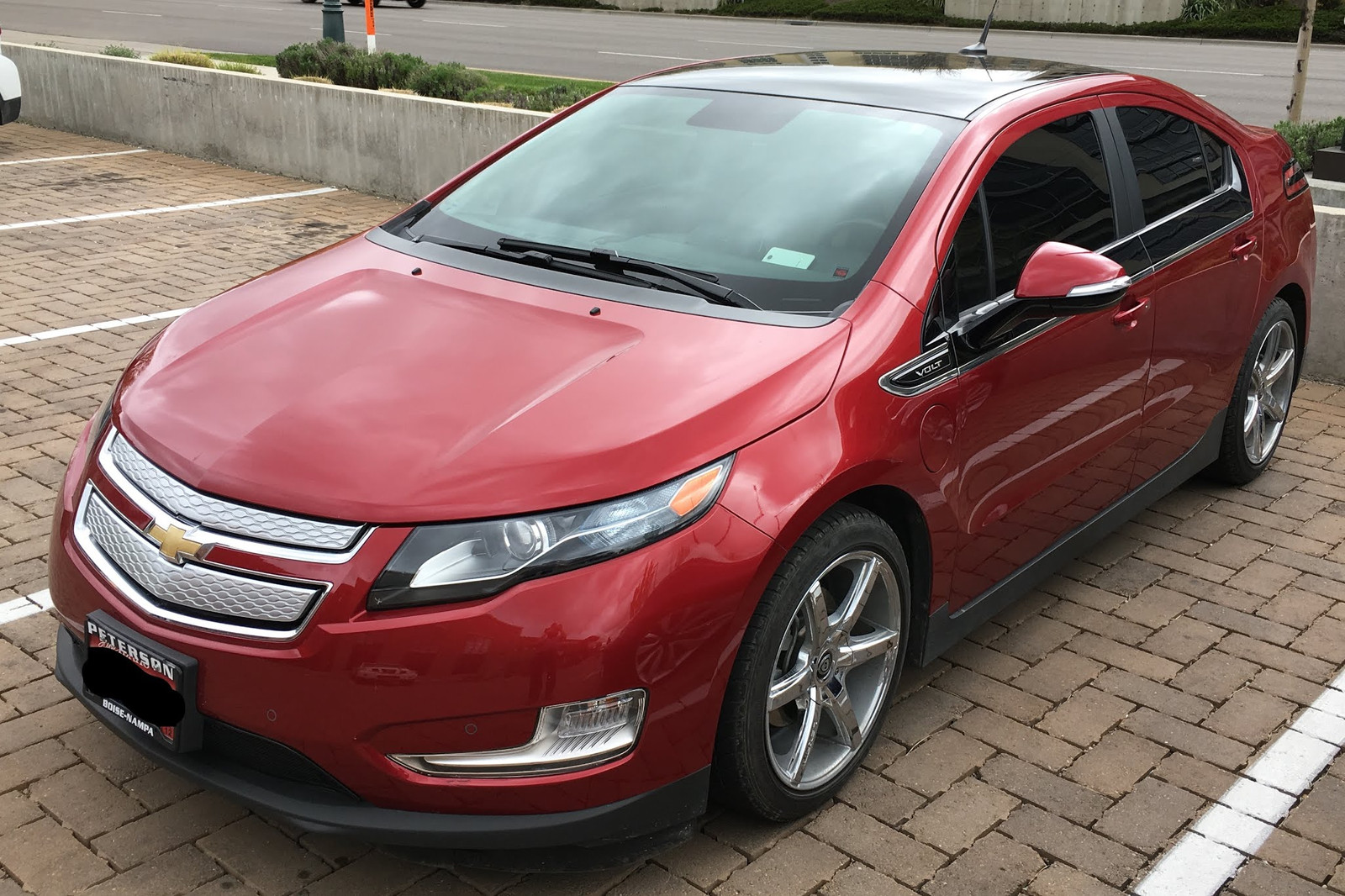
EV/BEV: Battery Electric Vehicle
Finally, there are the “pure” EVs (you’ll also see BEV - Battery Electric Vehicle). These have a large battery pack for power - that’s it. Range varies wildly, from about 60 miles in an older Leaf to over 300 miles in some of the Teslas. The EVs tend to be the cheapest to run, by far, because power is cheap, and there’s just not the same amount of maintenance required. There are no engine oil changes (you may have a gearbox oil change at some point), the system is a good bit easier on coolant than a gas engine (though, let’s be honest, nobody changes their coolant on schedule anyway), and you get the same benefits of regenerative braking to reduce brake system maintenance. They’re not maintenance free, but they sure are lower maintenance. The long range ones sure aren’t cheap to buy, though.
Be aware that most car salespeople just assume everyone gets the full $7500 EV tax credit and throws that into the pricing mix. If you don’t pay at least $7500 in federal taxes, and can’t come up with a way to do that (messing with retirement accounts is a common way), you don’t get the full $7500. Do the math yourself on this before talking to a salesman, or just buy used (you don’t get a tax credit, but the price on the used ones is low because the original owner got the tax credit).
You also use the battery for things like heat in the winter and air conditioning in the summer. There’s no “free heat” from the engine in the winter like there is with a gas motor, so range in the winter is typically a good bit less than the “rated” range. And, of course, you have to be able to charge them on a somewhat regular basis, or you find yourself walking. Conveniently enough, pretty much everyone has electricity to their house! I don’t know too many people who have a gasoline or diesel pipeline to their house, though farmers frequently have a tank and a delivery service.
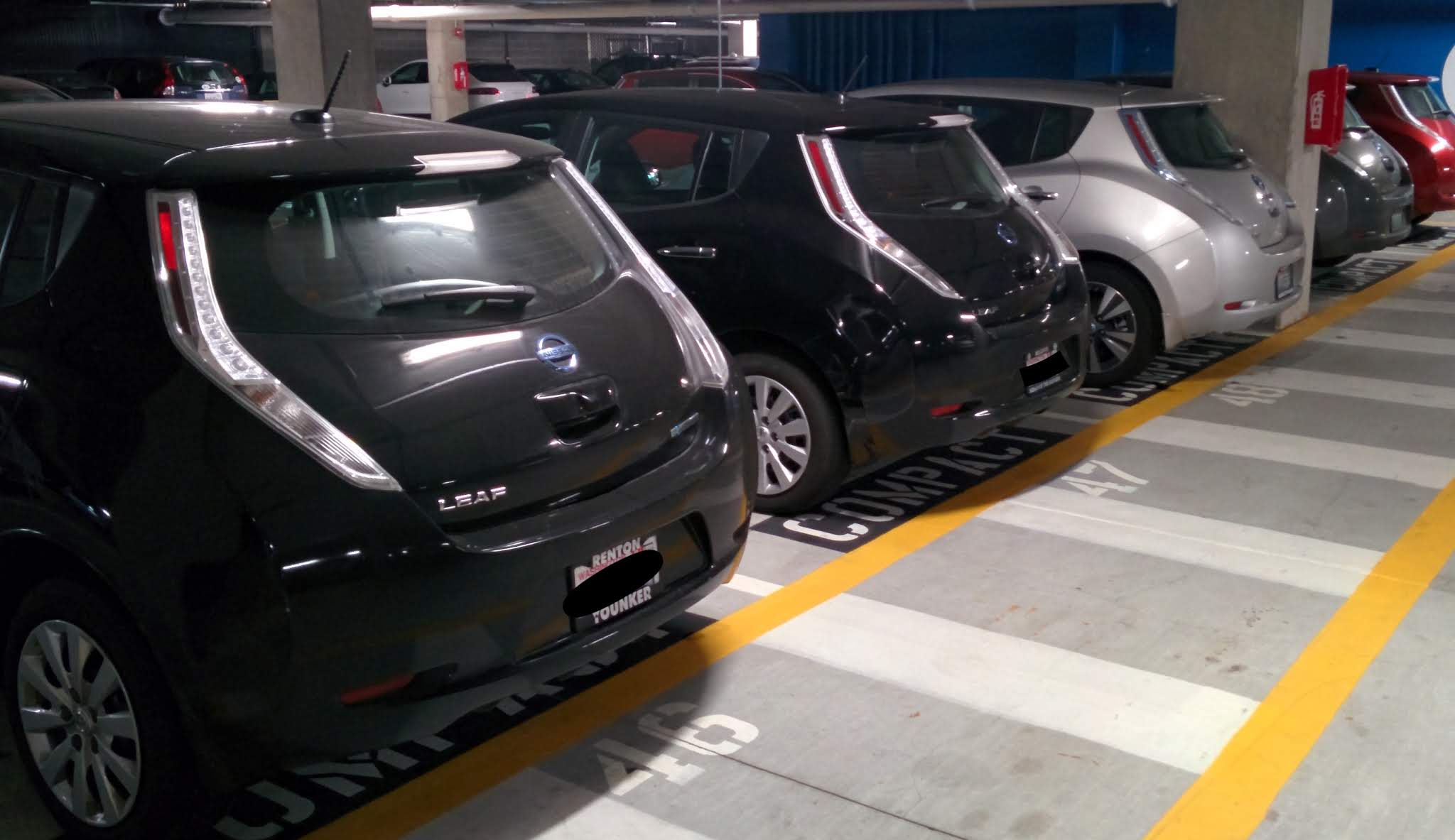 |
| A buttload of Leafbutts. |
REEV: Range Extended Electric Vehicle
Finally, there’s a weird spot between EVs and PHEVs - REEVs. Range Extended Electric Vehicles. This category exists because of California and consists of an electric vehicle with a small gas engine (think a motorcycle engine) and a peanut-sized gas tank (a few gallons) that will let you drive further than the battery, but not by too much. If the extended range is longer than the battery range, it’s a PHEV (according to California’s rules), and that doesn’t get you a HOV sticker, or… something like that.
The only one of these that really matters is the BMW i3, and… well, you can make your own decisions about if you want to drive one. They’re certainly unique looking. If you buy one, hack it so it thinks it’s a European car. You get the full gas tank capacity (2.4 gallons!) instead of a limited capacity, and you can use hold mode any time you want instead of only once the battery is drained. With a small range extender, climbing a mountain with an i3 and a drained battery is about like driving a loaded semi, so saving battery for climbing helps a lot.
I can’t come up with a good reason to buy one of these out here, though.
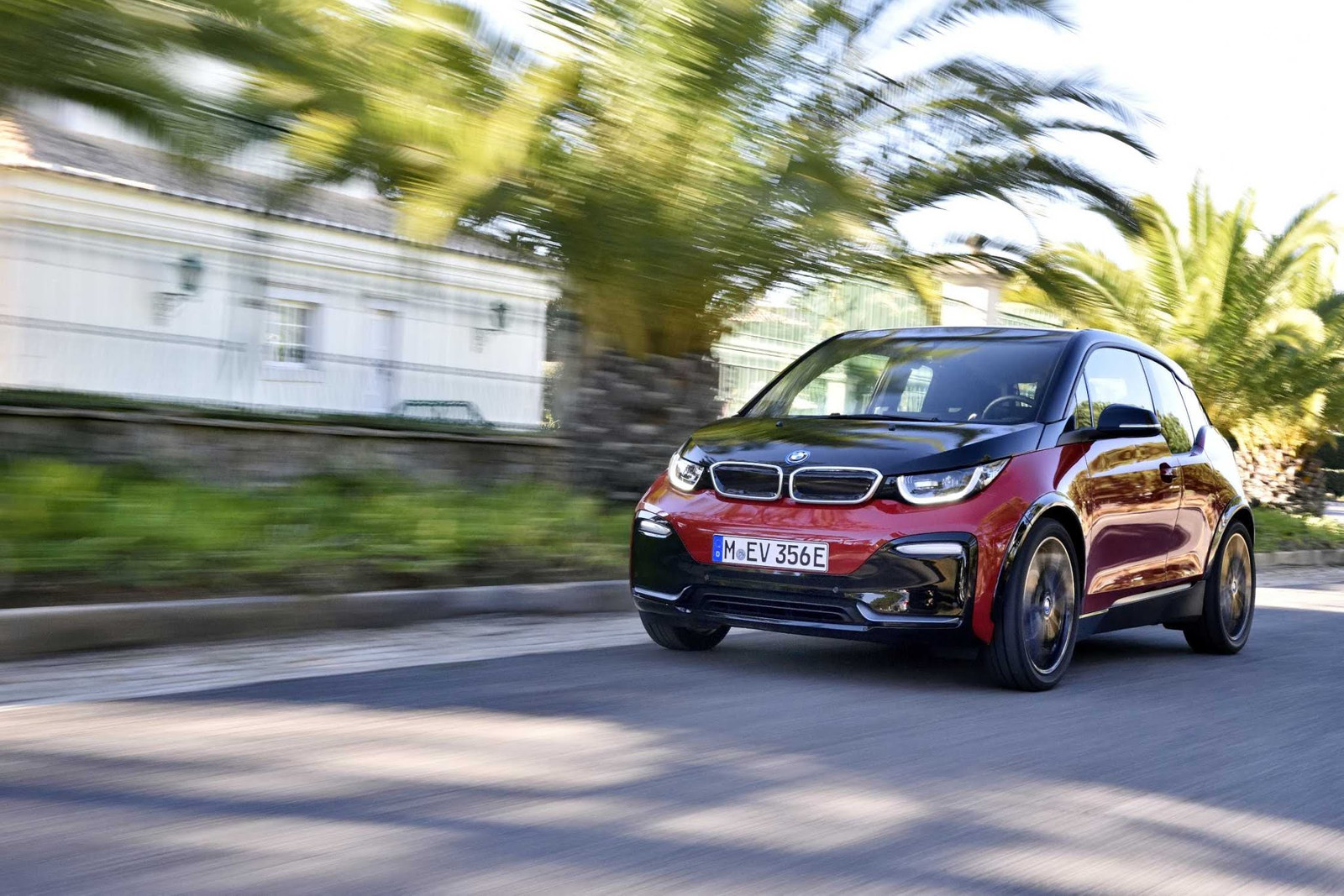
Cost to Run: Electricity is Cheap, Gasoline is Expensive
Obviously, there have to be some advantages of electric vehicles, or people wouldn’t be buying them. One of the major advantages out here is that we have cheap power (Idaho Power runs a large number of dams on the Snake River), and somewhat expensive gas (typically in the middle of the nation).
I’m using $0.10/kWh for power (a blended average of summer and winter mid-tier rates), a few different gas prices, and a slightly synthetic set of driving numbers based around what people out here tend to do (at least in my experience). We’ll use 30 miles a day each weekday, and 50 miles on Saturday/Sunday (as a combined drive without charging in between). This works out to 13,000 miles/yr, which is a hair above the national average, but not unreasonable out here. What do annual fuel costs look like with this sort of driving?
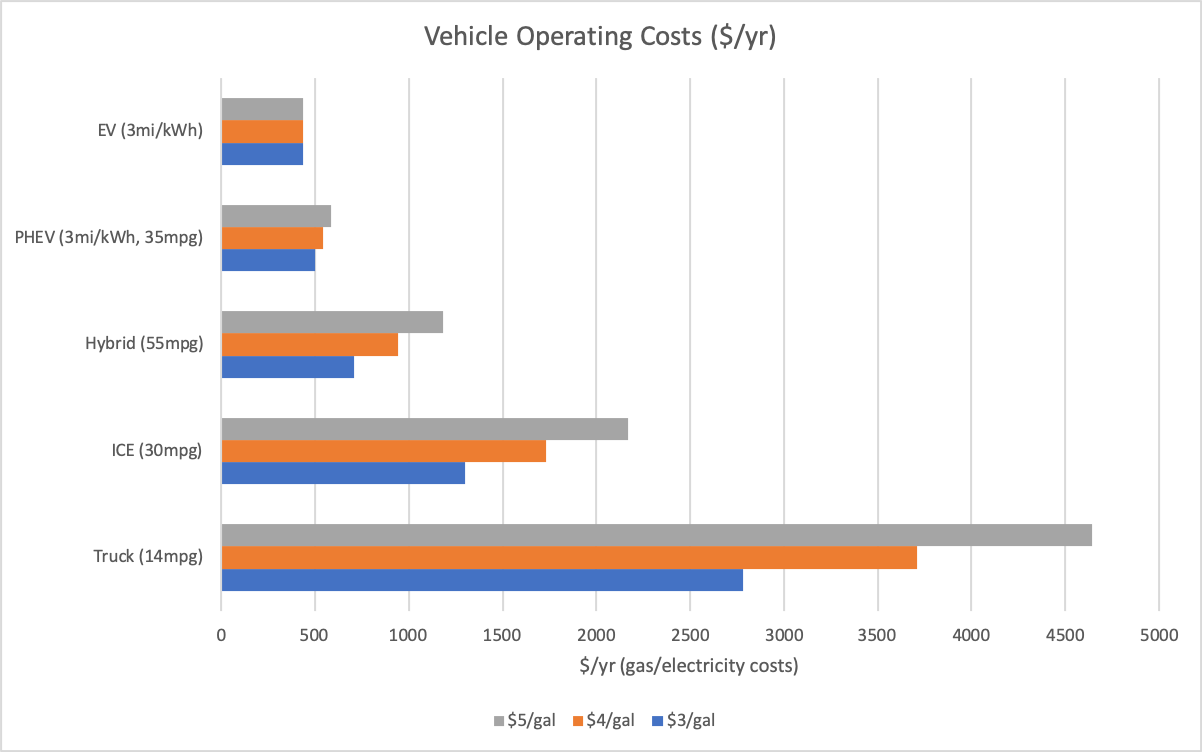
Truck: 14mpg, $2784 ($3/gal), $3712 ($4/gal), $4642 ($5/gal)
If you were to do all this driving in a truck, at 14mpg, you run 928 gallons a year through the engine for an annual fuel cost of around $3000-$4000 (depending on fuel price). If you own a truck, you know the rest of the maintenance isn’t cheap either - this doesn’t count tires or anything else, so actual operating costs for a year are likely to be comfortably north of $5000.
ICE Car: 30mpg, $1299 ($3/gal), $1732 ($4/gal), $2167 ($5/gal)
A small car, getting 30mpg, sucks down 433 gallons, but still costs over $1000/yr in fuel costs alone.
Hybrid: 55mpg, $708 ($3/gal), $944 ($4/gal), $1182 ($5/gal)
Going to a hybrid at 55mpg, you use 236 gallons a year, and the fuel savings are significant - under $1000/yr. But what happens if we start using electricity instead?
PHEV: 333Wh/mi, 35mpg, $497 ($3/gal), $540 ($4/gal), $585 ($5/gal)
Moving to something like a Volt, you’ll see around 3 miles per kWh of power used. It varies depending on temperature and climate control settings (I see north of 4 in the summer, around 2 in the winter), but that’s a decent average for all around use (it’s actually somewhat pessimistic). If you’ve got a 35 mile range on battery, every week day’s driving is done purely on electricity, and the weekend driving is 35 miles on electric, plus 15 miles on gas.
Every day, you spend $1 on power, and then on the weekend, you burn 0.85 gallons of gas (for those 30 miles). Not only does this work out to be significantly cheaper than a hybrid, it reduces your sensitivity to gas prices. Even at $5/gal, it just doesn’t impact your annual fuel cost by much.
Of course, if you have a 2nd gen Volt with a 50+ mile battery range, your fuel numbers look like a pure EV for this synthetic test!
BEV: 333Wh/mi, $433 ($3/gal), $433 ($4/gal), $433 ($10/gal)…
Finally, a pure electric vehicle comes in far less expensive to run than the other options - regardless of gas price. It doesn’t matter what the pump prices do, because you’re charging on electricity! As long as you’ve got the range for your driving, your driving costs are extremely low, and gas prices are a curiosity you might pay attention to as you drive past - or you might not. They don’t bother you!
Your Mileage May Vary
Obviously, that synthetic situation doesn’t cover everyone’s driving cases perfectly, but it demonstrates the point - electric vehicles (or plug in hybrids) are far, far cheaper to run than even a very efficient gas car, and still come in cheaper than a hybrid. Our power out here is cheap - so we may as well make use of it. Even with low gas prices, EVs still come in ahead of a hybrid, but as gas prices rise, the costs of driving rise far more slowly with a PHEV or EV.
Play with the numbers for your driving situation, and see how they turn out. The difference between a 30mpg car and an electric is quite substantial.
Throwing a long trip or two a year in doesn’t really change the numbers by much (assuming you can make the trip with an EV). What does chew up the savings in a hurry, though, would be adding a ton of truck miles to do things a pure EV can’t do. That’s not going to work very well, which is why we have a Volt instead of a Leaf.
And, yes, I know the solar installers out here are trying to claim that power costs will rise by 3%/yr, every year, and that’s directly at odds with what Idaho Power has been doing lately.
I’m also not including maintenance costs. EVs typically have lower maintenance than an ICE, but it depends on the car. A powerful AWD EV like some of the Teslas, not driven carefully, can chew through a set of tires awfully quickly. A friend’s cost per mile, in tires, was about the same as the gas cost for a 30mpg car.
Charging: At Home and Out
If you have an electric vehicle (or a plug in hybrid), you’ll need to charge it - and you’ll want to charge it at home. One very real downside to EVs in the Treasure Valley is that we don’t have much in the way of charging infrastructure in town. If you look at PlugShare (a site that shows public charging points) for the Boise area… it’s sparse. Half of what you see is car dealerships, which are worth avoiding for charging unless you want to spend your time educating car salesmen about EVs. My experience with them has been that they know nothing about EVs/PHEVs, because, in the words of one I asked, “Anyone who comes in looking for [an EV/PHEV] isn’t going to buy anything else, and they know more about the car than I do, so why should I bother learning about it?”

If you look at Portland, which has far better charging infrastructure, you can see the difference. Chargers are all over, and along main routes of travel. It makes things easier, but it doesn’t make a big difference if you have proper charging at home and enough range.

What this means, practically, is that you’ll be charging almost exclusively at home. This is fine - and, given our power costs, it’s far cheaper than most public charging stations anyway! If you’re in the Treasure Valley area and don’t have a place to charge at home, an EV just isn’t for you right now.
Modern EVs don’t have a regular wall plug on them. They typically use a J1772 connector type, which is a rugged connector that’s safe for outdoor use. You can’t shock yourself, they’re waterproof, they properly handle being removed from the car under load (they’ll cut load before the main contacts come out), etc. These come attached to something called an EVSE - Electric Vehicle Supply Equipment. This unit handles making sure the car is able to charge safely, so it communicates about the available circuit capacity, checks for ground faults, and generally does a variety of things that help prevent car charging from going terribly wrong. You’ll need one. Cars typically come with a small one, but installing a fixed one is often helpful. Your local electrician can help you out, but a 240V/50A circuit is more than enough for any EV on the market - and if you have multiple EVs, there are some EVSEs that can share an outlet (the full 40A if only one car is charging, or split it 20A/20A with two cars, etc).

If you find yourself places with outlets you can use regularly, tossing an EVSE and extension cord in the back of your car might make sense. I’ve got a Duosida (about $180 on eBay) I carry around with me to charge at some friends places when I’m there for a few hours. Adding a few miles of range per hour of charging adds up when you’re playing D&D for 5 hours!
It’s Full Every Morning!
One of the biggest differences with any sort of electric vehicle is that the battery is full every morning! It doesn’t sound like that big a deal until you actually live with it - and it’s huge. It means that you start every day with the full rated electric range, ready to go. Even if you’ve got a shorter electric range (like the 35 miles on a Gen 1 Volt), you start the day’s driving with that battery range. This is why a Volt consumes far less fuel than a Prius for typical driving, even though in steady state long distance driving, the Prius is a good bit more efficient. We’ve put about 12k miles on our Volt with 65 gallons of gas. A Prius would have used 220 gallons - and 15 of our gallons were from an antique car meet we drove to.
On a long distance day for us (90-100 miles in a day, which happens often enough), the average fuel economy for the day will still be better than a Prius, because we’ve got the 35 electric miles at the start of the day. If the car has some time in the afternoon to charge before going out in the evening, we’ll see 90-100 miles per gallon of gas used for the day. It really works out well.
With very few exceptions, people with EVs charge at home. You can charge from 120V and have things work (we do), but in most cases you’ll want a 240V charger. The cost to install one varies, but more and more homes have outlets in the garage anyway (or, at least, the breaker panel - adding an outlet typically isn’t that expensive).
To make 120V charging work, you either need something like a PHEV (we’ve been charging our Volt from 120V for the past year without problems) or a very long range BEV. If you charge 12 hours at 120V/12A, you can add 50-60 miles of range overnight, or nearly 400 miles a week. But, if you have a long day or two in a row, you won’t make it up overnight. Just budget for a 240V outlet and the problem goes away. But if you can’t charge on 240V, don’t worry - 120V charging still works quite well, especially with a PHEV.
DC Fast Charging (DCFS)
The next logical question, though, is about longer trips. For some people, this isn’t a concern because there’s another vehicle that they’d take on longer trips. For some vehicles (the PHEVs, typically), this isn’t a concern because they have a gas engine. But what if you have a pure BEV and want to take a longer trip?
You can use DC Fast Chargers. The best-known system is Tesla’s “Superchargers,” though at this point there are plenty of DC fast chargers for other BEVs as well. You’d need a car that supports it, and it’s certainly not as fast as filling up with gas, but it’s possible to charge quite quickly with DCFS.
Instead of doing the AC/DC conversion in the car (which rarely exceeds 7-8kW of charger capacity), the conversion is done externally. The (rather hefty) connector hooks up straight to the car’s battery pack and feeds raw DC amps into the pack. This allows charging at rates north of 100kW.
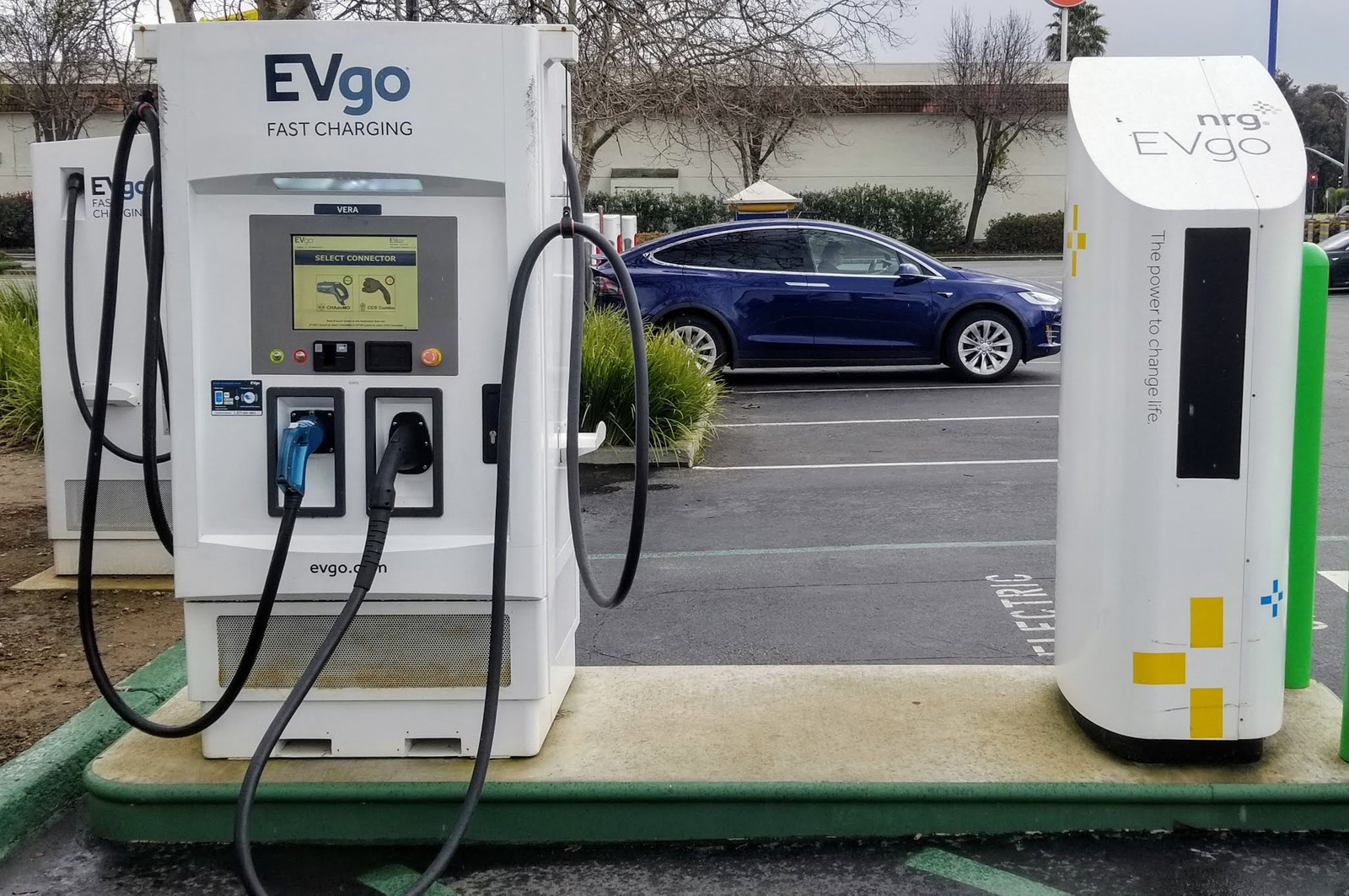
That said, out here? I wouldn’t rely on it. We do have some DC fast charging in the area, but they’re limited, may or may not be working (sadly), and it’s the sort of thing that I might not try for a family trip quite yet. Eventually, it should be possible, but for now? Maybe not.
This is what the non-Tesla DCFS network (via Plugshare) looks like in Idaho and surrounding states, and you can tell it’s pretty sparse out here. Adding Tesla Superchargers doesn’t change it much. There are a lot of “If this one charger is offline, you’re stuck” routes out here, which is part of why I’m not a fan of a pure BEV as an only vehicle.

Multiple Vehicles & Transport Optimization
A common complaint people have about EVs is that they can’t do everything - which is entirely true! I can’t drive a Leaf from Boise to Chicago without an awful lot of hassle, planning, and time. There are some stretches far longer than the battery range without public charging stations. Does this mean a Leaf is useless? Certainly not - because, in the Treasure Valley, most people have enough space for multiple vehicles. Use an EV for what it’s good for, use other vehicles for what they’re good for, and keep the commute miles off more expensive to run vehicles.
We’ve got quite a few vehicles, if you count the motorcycles (I’m trying to sell some of them - want a Buell or two?). What vehicle goes on a trip is determined by what the trip requirements are. The bulk of our miles are on the Volt. If I’m going somewhere and my wife needs the car, I’ll take a motorcycle. For camping up in the mountains somewhere off a questionable gravel road, we take the truck. If I’m hauling a ton of concrete mix, I’ll use the truck. I don’t have a commute since I work from the property, but an EV is often perfect as a dedicated commuter/around town car and saves more than enough to make it useful.
What often works well is to have an EV for local driving and then something longer ranged (and higher capacity) for longer trips - a minivan, a truck, a large car. Because vehicles don’t really rust out here, keeping miles off a vehicle means it lasts longer. I put about 2000 miles/yr on my truck, and I hope to keep it running an awful lot of the rest of my life (even with 3000 miles/yr, another 60 years won’t even put the odometer to 300k - on a truck that can easily run far past that).
So don’t discount one simply because it can’t do everything you need in a car. Consider it for the common case driving. Even if you really like your other vehicle, an EV saves it for the fun miles, not the “going back and forth down I-84” miles.
Of course, you could also go with a PHEV like a Volt or Pacifica and have the best of both worlds!
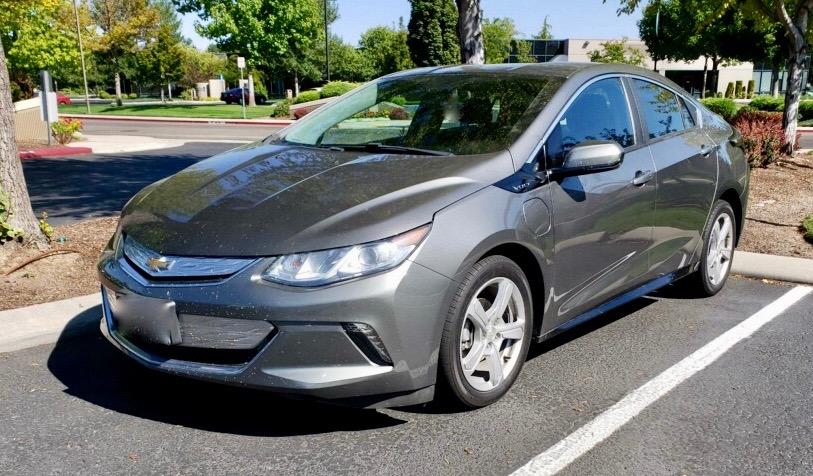
Winter & Heating
One thing you do have to consider with an EV that most people don’t think about is heat. With an ICE, heat is just a free byproduct of the power generation process, so heat in the winter just happens. With an EV, the power flow from battery to wheels is way more efficient - so there’s not much waste heat in the first place. This means that EVs typically will use some form of heater off the battery to heat the cabin, and this can take an awful lot of power in the winter. Combine that with a cold battery pack and winter range can be as bad as 50-60% of the summer range. Normally it’s somewhat better, but a pure BEV needs to have a good range margin to cover driving in the dead of winter. Pounding through snow and ice isn’t easy!

You can improve things significantly by preheating when connected to the charger. Most EVs have some way to turn the heater on remotely - either with the key fob or an app. If you heat the car up with power from the grid, it doesn’t use battery range for heat. Plus, in many cases, the car will start heating the battery pack up so you have a happier battery when setting off.
If you commute and the car sits outside at work, it’ll take some range off the battery to heat it up getting home. However, most EVs also come with heated seats - and heating the person is a whole lot more efficient than heating the entire interior of the car!
The car may also take longer to charge in the winter. Lithium shouldn’t be charged when cold (you get lithium plating and permanent capacity loss), so the cars typically will heat the battery if it’s too cold. This takes a bit of time and energy, but it’s good for battery longevity.
Just be aware - it’s totally workable, but something that’s on the edge of range in the summer will fall short in the winter.
Battery Longevity & Degradation
Another common concern about EVs is the battery life. Cell phones and laptops all age and the battery life starts to suck, so it’s reasonable to assume that would happen with a battery powered car - and it does.
But not to nearly the same extent - because EV manufacturers aren’t idiots like cell phone manufacturers.
For the most part, EVs take far better care of their battery than your phone or laptop does - and they frequently use a different battery chemistry that lasts longer. In general, lithium batteries are most stressed when fully charged and when hot. Your pocket is quite hot, and your phone, under use, gets even hotter. Plus, phone manufacturers shove as much power in that battery as they possibly can to get the longest runtimes for the review sites in the first dozen charges, and beyond that? Whatever. You’ll probably throw it out before it gets too bad. This, of course, turns into a problem when people start keeping phones past 2 years or so, but it’s not how EVs treat their battery pack. I know you can find a lithium chemistry that holds up to 4.4V/cell (and that’s what many modern phones charge to, horrifyingly enough). Should you? Well… I’d answer with a solid “No.” But then you might lose half an hour of the Almighty Review Runtime in exchange for an extra year or two of battery longevity. The horror!
With the notable exception of the Nissan Leaf and the eGolf, just about everyone building EVs has a way of heating and cooling the battery pack. This is used to keep the temperatures reasonable, which helps longevity a lot. The other trick commonly used is simply not filling the pack all the way up. The Volt only uses the center of the battery pack capacity (it’s never past about 85% full when “full”), and most other EVs let you select the charge percentage you want. Filling to 80% or 90% for daily driving and only filling the pack completely before a long trip really, really helps improve battery longevity. I looked at this a few years ago and nothing much has changed, except we have more data that a thermally managed battery pack lasts a really long time.
The reality is that for most EVs out there, it’s simply not a concern. The packs will easily last a decade or two in normal service. Just plug the car in when not in use and let it manage things. Of course, with a Volt, if the pack degrades, you just use a tiny bit more gas. Even if our battery pack degraded to only 20-25 miles, that still covers an awful lot of driving before the gas engine kicks on - but that sort of capacity loss also just isn’t happening.
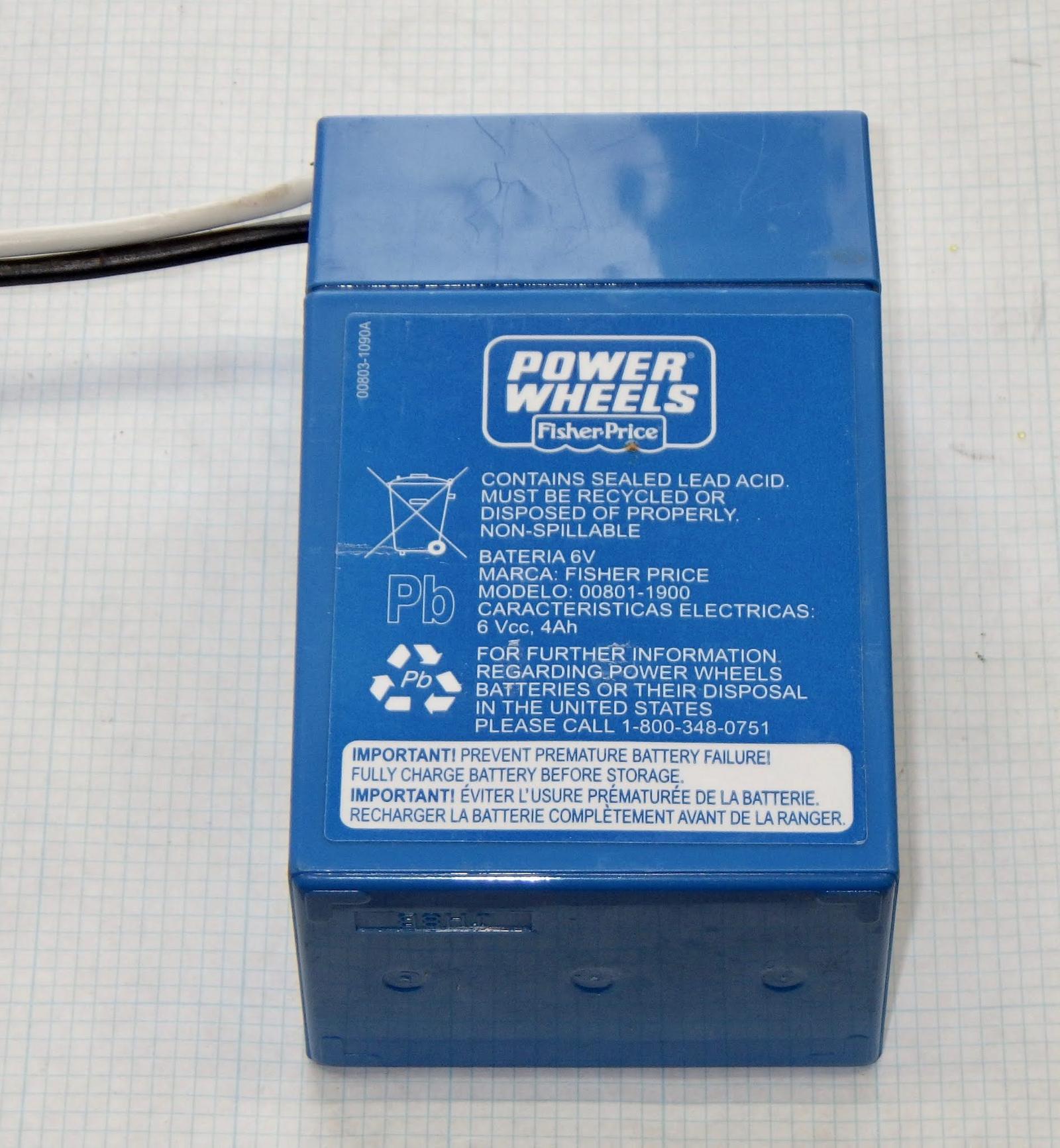
Then there’s Nissan. They believed the battery manufacturer’s datasheet and didn’t bother putting thermal management on the cells in the Leaf. In hot climates (Phoenix), the battery just didn’t last. They’re a bit of a worst case, because the early Leafs had a small battery pack to start with, so always charged it completely. Throw in asphalt-melting ambient temperatures, and you’ve got problems. Try to get a Leaf from somewhere with a moderate climate - Seattle or Portland would be perfect. It doesn’t get hot enough, long enough, to really be a problem in the Treasure Valley, but I wouldn’t expect a battery pack to last forever on one. They’re cheap enough that you can drive one for a while, sell it, and still come out ahead on the gas costs, though. Maybe park it in the shade when you can.
But even if you do need a major repair or a battery pack at some point, the cost of running is enough lower that it’s likely to be a wash with paying for gas (and there’s still no guarantee that a gas car won’t have a major repair).
Let’s take our Volt. We run about 200 miles per gallon of gas used. For 100k miles, that means I’ll burn about 500 gallons of gas ($1500) covering around 17500 miles of driving. The remaking 82500 miles, at a pessimistic 3mi/kWh, will run me $2750 in power - for a total cost of $4250. That’s a lot - but doing the same distance at 35mpg would require nearly 2900 gallons of gas and cost me $8600. That’s a difference of $4350 over 100k miles in operating costs in energy alone - that’ll cover some pretty significant repairs!
So: Consider an EV!
All that is the very long form of, “Consider an electric vehicle out here!” They do work, and prices on the used market are down low enough that they even make sense to add as just another vehicle to the fleet!
I do still think the PHEVs (mostly the Chevy Volt) are a good optimum around here, but if you’re just adding to a fleet, a lightly used Leaf would make a ton of sense.
Of course, if you have a lot of money and don’t care about unrepairable nonsense, there’s always Tesla, but I just can’t suggest buying a car that’s only got one option for service for that sort of money.
Boise’s National Drive Electric Week Event: Sept 14, 2019
And, if you’re out here and curious, come check out the National Drive Electric Week event on Saturday Sept 14th! It’s in Boise, at 1500 Shoreline Drive, 9AM - 1PM. I’ll be out there with our red Volt and likely a solar panel and power toolbox.
Comments
Comments are handled on my Discourse forum - you'll need to create an account there to post comments.If you've found this post useful, insightful, or informative, why not support me on Ko-fi? And if you'd like to be notified of new posts (I post every two weeks), you can follow my blog via email! Of course, if you like RSS, I support that too.



